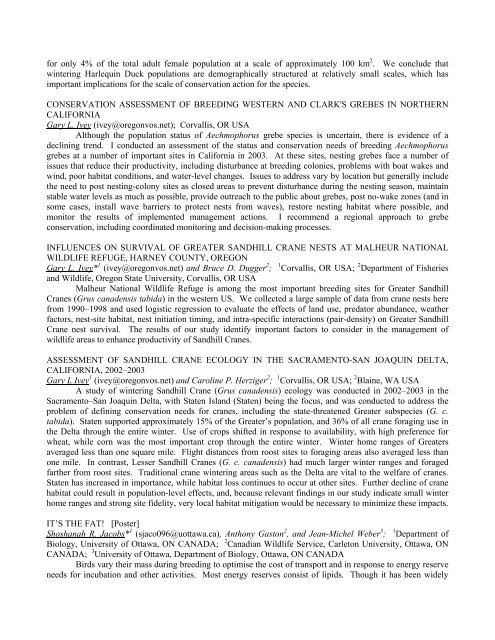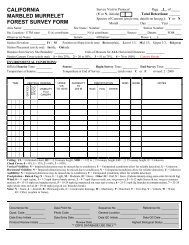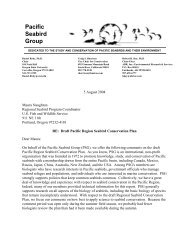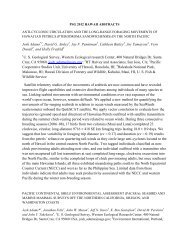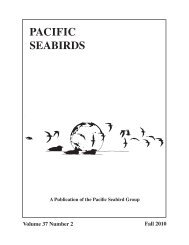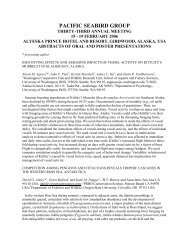abstracts of oral and poster presentations - Pacific Seabird Group
abstracts of oral and poster presentations - Pacific Seabird Group
abstracts of oral and poster presentations - Pacific Seabird Group
You also want an ePaper? Increase the reach of your titles
YUMPU automatically turns print PDFs into web optimized ePapers that Google loves.
for only 4% <strong>of</strong> the total adult female population at a scale <strong>of</strong> approximately 100 km 2 . We conclude that<br />
wintering Harlequin Duck populations are demographically structured at relatively small scales, which has<br />
important implications for the scale <strong>of</strong> conservation action for the species.<br />
CONSERVATION ASSESSMENT OF BREEDING WESTERN AND CLARK'S GREBES IN NORTHERN<br />
CALIFORNIA<br />
Gary L. Ivey (ivey@oregonvos.net); Corvallis, OR USA<br />
Although the population status <strong>of</strong> Aechmophorus grebe species is uncertain, there is evidence <strong>of</strong> a<br />
declining trend. I conducted an assessment <strong>of</strong> the status <strong>and</strong> conservation needs <strong>of</strong> breeding Aechmophorus<br />
grebes at a number <strong>of</strong> important sites in California in 2003. At these sites, nesting grebes face a number <strong>of</strong><br />
issues that reduce their productivity, including disturbance at breeding colonies, problems with boat wakes <strong>and</strong><br />
wind, poor habitat conditions, <strong>and</strong> water-level changes. Issues to address vary by location but generally include<br />
the need to post nesting-colony sites as closed areas to prevent disturbance during the nesting season, maintain<br />
stable water levels as much as possible, provide outreach to the public about grebes, post no-wake zones (<strong>and</strong> in<br />
some cases, install wave barriers to protect nests from waves), restore nesting habitat where possible, <strong>and</strong><br />
monitor the results <strong>of</strong> implemented management actions. I recommend a regional approach to grebe<br />
conservation, including coordinated monitoring <strong>and</strong> decision-making processes.<br />
INFLUENCES ON SURVIVAL OF GREATER SANDHILL CRANE NESTS AT MALHEUR NATIONAL<br />
WILDLIFE REFUGE, HARNEY COUNTY, OREGON<br />
Gary L. Ivey* 1 (ivey@oregonvos.net) <strong>and</strong> Bruce D. Dugger 2 ; 1 Corvallis, OR USA; 2 Department <strong>of</strong> Fisheries<br />
<strong>and</strong> Wildlife, Oregon State University, Corvallis, OR USA<br />
Malheur National Wildlife Refuge is among the most important breeding sites for Greater S<strong>and</strong>hill<br />
Cranes (Grus canadensis tabida) in the western US. We collected a large sample <strong>of</strong> data from crane nests here<br />
from 1990–1998 <strong>and</strong> used logistic regression to evaluate the effects <strong>of</strong> l<strong>and</strong> use, predator abundance, weather<br />
factors, nest-site habitat, nest initiation timing, <strong>and</strong> intra-specific interactions (pair-density) on Greater S<strong>and</strong>hill<br />
Crane nest survival. The results <strong>of</strong> our study identify important factors to consider in the management <strong>of</strong><br />
wildlife areas to enhance productivity <strong>of</strong> S<strong>and</strong>hill Cranes.<br />
ASSESSMENT OF SANDHILL CRANE ECOLOGY IN THE SACRAMENTO-SAN JOAQUIN DELTA,<br />
CALIFORNIA, 2002–2003<br />
Gary L Ivey 1 (ivey@oregonvos.net) <strong>and</strong> Caroline P. Herziger 2 ; 1 Corvallis, OR USA; 2 Blaine, WA USA<br />
A study <strong>of</strong> wintering S<strong>and</strong>hill Crane (Grus canadensis) ecology was conducted in 2002–2003 in the<br />
Sacramento–San Joaquin Delta, with Staten Isl<strong>and</strong> (Staten) being the focus, <strong>and</strong> was conducted to address the<br />
problem <strong>of</strong> defining conservation needs for cranes, including the state-threatened Greater subspecies (G. c.<br />
tabida). Staten supported approximately 15% <strong>of</strong> the Greater’s population, <strong>and</strong> 36% <strong>of</strong> all crane foraging use in<br />
the Delta through the entire winter. Use <strong>of</strong> crops shifted in response to availability, with high preference for<br />
wheat, while corn was the most important crop through the entire winter. Winter home ranges <strong>of</strong> Greaters<br />
averaged less than one square mile. Flight distances from roost sites to foraging areas also averaged less than<br />
one mile. In contrast, Lesser S<strong>and</strong>hill Cranes (G. c. canadensis) had much larger winter ranges <strong>and</strong> foraged<br />
farther from roost sites. Traditional crane wintering areas such as the Delta are vital to the welfare <strong>of</strong> cranes.<br />
Staten has increased in importance, while habitat loss continues to occur at other sites. Further decline <strong>of</strong> crane<br />
habitat could result in population-level effects, <strong>and</strong>, because relevant findings in our study indicate small winter<br />
home ranges <strong>and</strong> strong site fidelity, very local habitat mitigation would be necessary to minimize these impacts.<br />
IT’S THE FAT! [Poster]<br />
Shoshanah R. Jacobs* 1 (sjaco096@uottawa.ca), Anthony Gaston 2 , <strong>and</strong> Jean-Michel Weber 3 ; 1 Department <strong>of</strong><br />
Biology, University <strong>of</strong> Ottawa, ON CANADA; 2 Canadian Wildlife Service, Carleton University, Ottawa, ON<br />
CANADA; 3 University <strong>of</strong> Ottawa, Department <strong>of</strong> Biology, Ottawa, ON CANADA<br />
Birds vary their mass during breeding to optimise the cost <strong>of</strong> transport <strong>and</strong> in response to energy reserve<br />
needs for incubation <strong>and</strong> other activities. Most energy reserves consist <strong>of</strong> lipids. Though it has been widely


